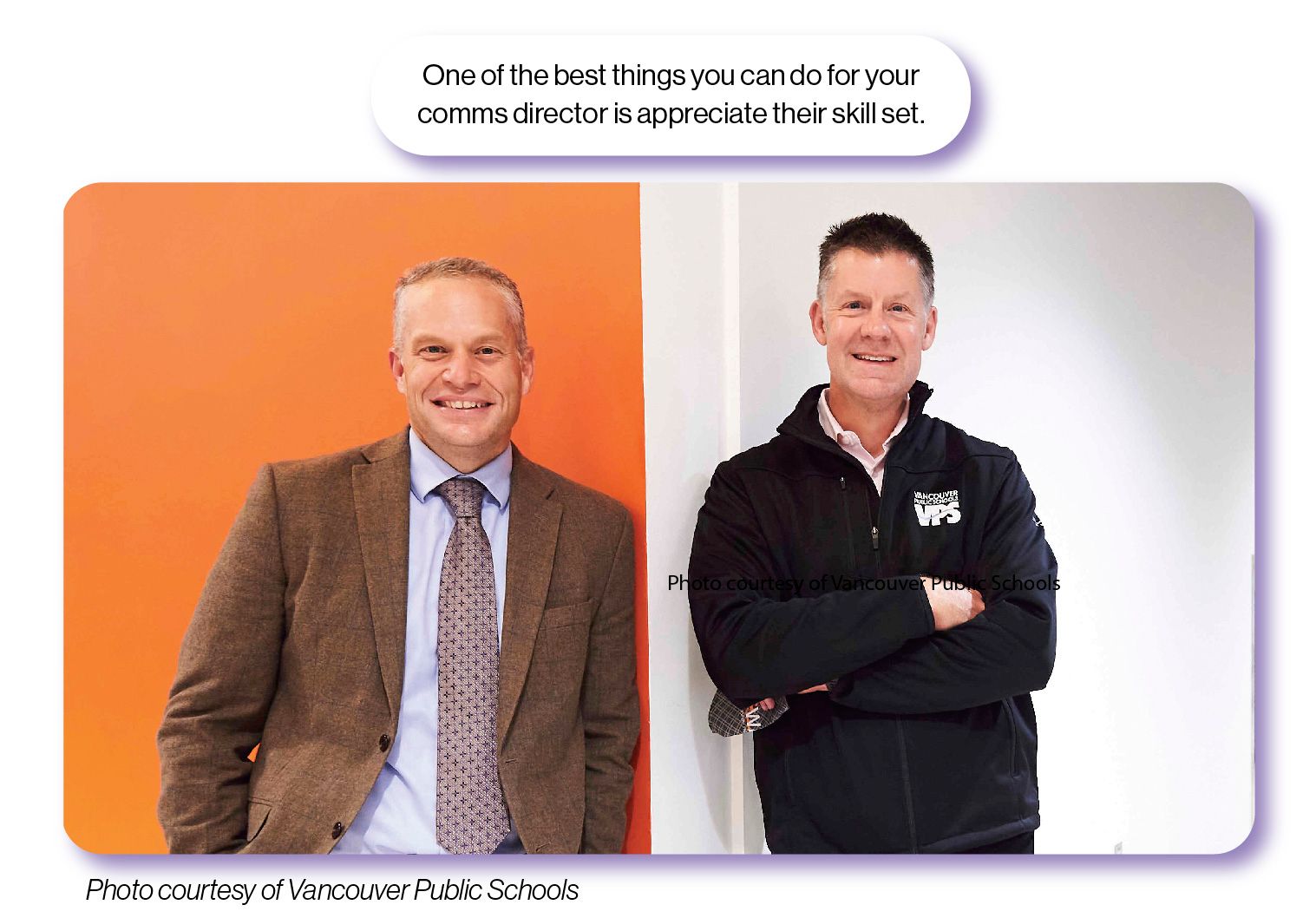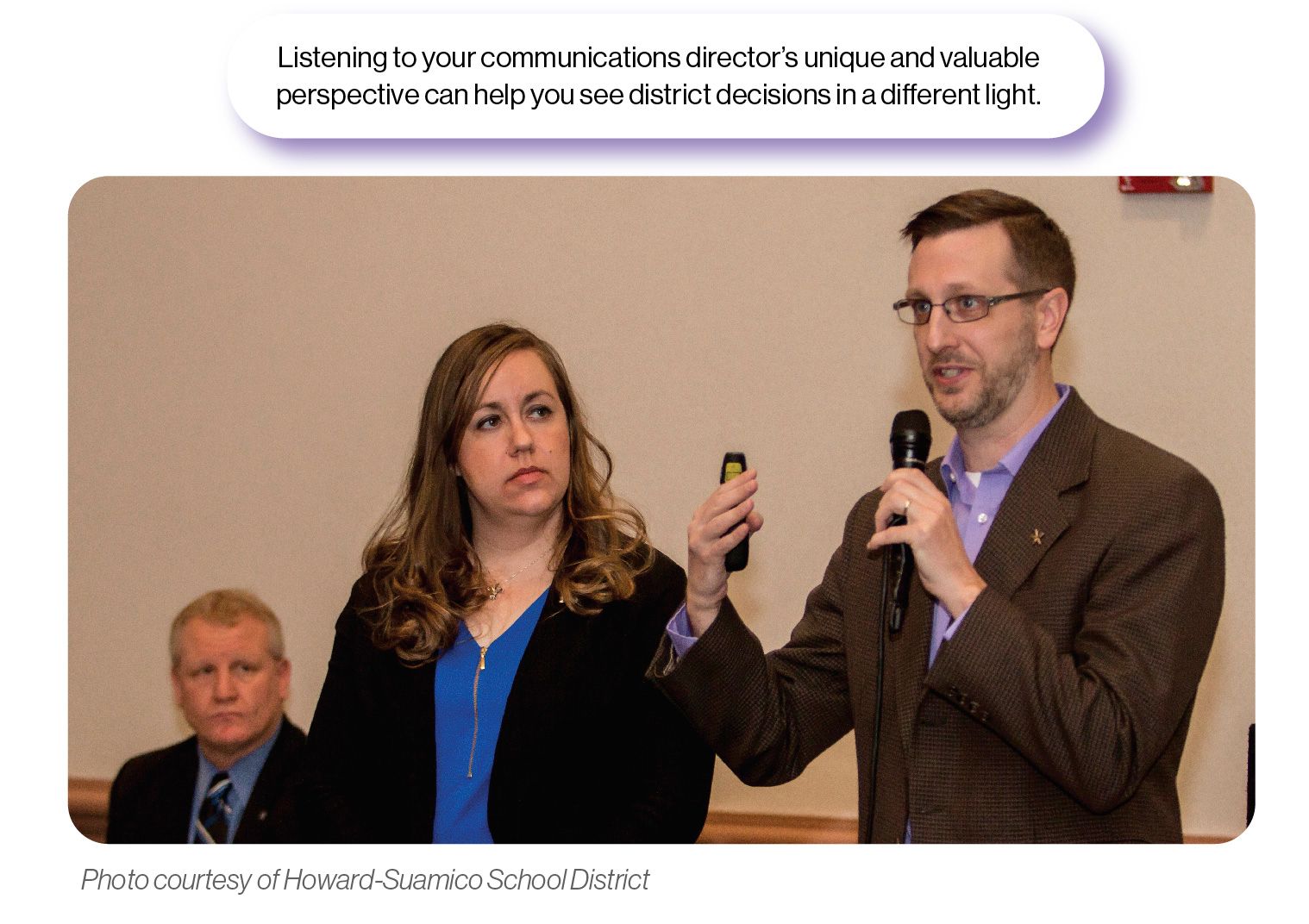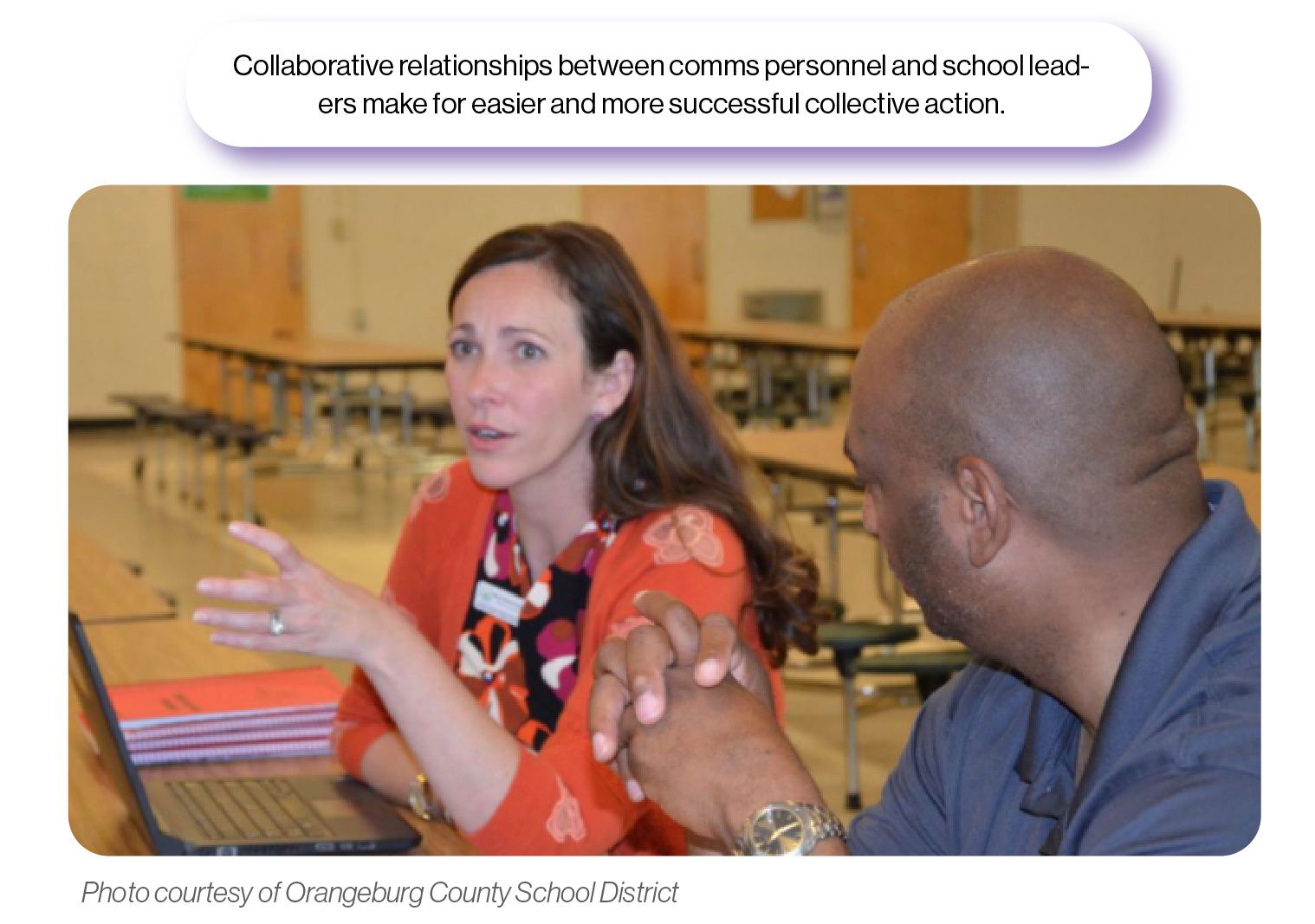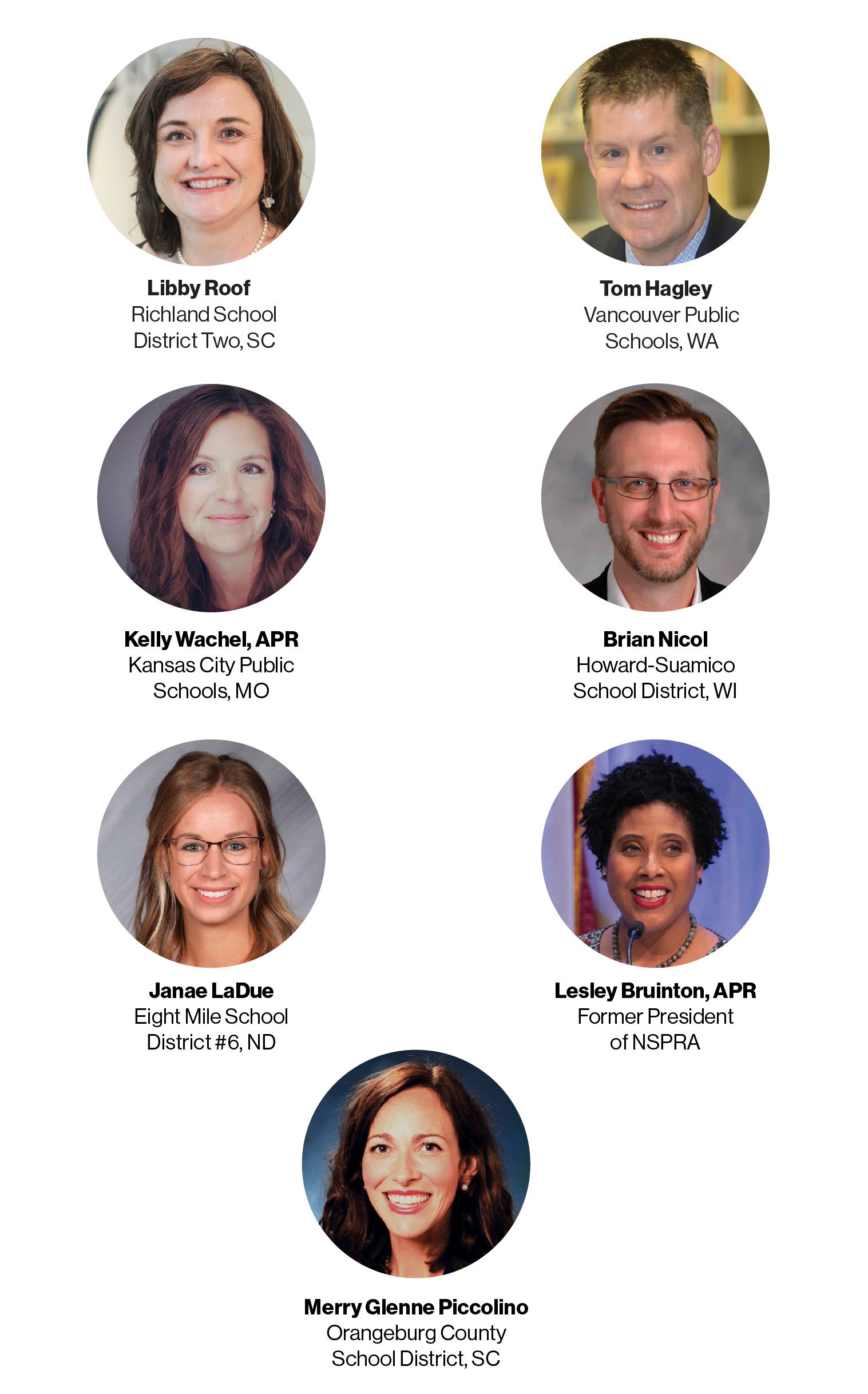Championing Your Comms Directors
How superintendents can support communications professionals

Kelly Wachel, APR, joins our Zoom meeting at 10 a.m. on a Wednesday. Behind her, the beige interior of a car shifts in and out of focus as light pours down from her sunroof. She gently shrugs off our concern about whether we should reschedule our call, that maybe she has too much on her plate for the day. Instead, she insists she’s happy to answer our questions while sitting in the parking lot of the next school she intends to visit. Wachel, the Chief Marketing and Communications Officer for Kansas City Public Schools in Missouri, is obviously comfortable with a busy schedule.
We’re centering our conversation around a deceptively simple question: How can school administrators best support their communications professionals? Wachel admits that, when she first received our email, she thought we’d gotten the question backward. After all, she’s used to supporting school administrators, so her own needs are not too frequently discussed. But, especially during these times, this is a conversation worth having.
We don’t need to rehash the difficulties caused by COVID-19, but suffice it to say that school communications departments haven’t had an opportunity to breathe since March 2020. “I don’t think there has been any downtime in the last year and a half,” Wachel says. “With COVID communications, you’re constantly changing, reframing, and updating.” Educators are often the first to put themselves and their self-care to the side—and school communications professionals are no exception.
As the pandemic continues to take its toll on school communities, now is the time to consider what steps you can take to help your comms professionals perform at their highest and healthiest levels. So we sat down with communications practitioners from across the country to discuss what they need to thrive.
Of course, your district may not have a full communications staff—or even a designated comms person—but the ideas here apply regardless of your situation. So long as someone is communicating for your district, this is for you.
Respect
Merry Glenne Piccolino, Assistant Superintendent for Communications in South Carolina’s Orangeburg County School District, tells us the field of communications is “often overlooked, and it doesn’t get the respect or resources it deserves.” When it comes to supporting your communications director, Piccolino believes you must first recognize that the role is not “fluff,” but rather one that requires expertise.
“If you look at the size of a comparable company’s communications department—how big is it?” Piccolino asks. More than likely, a business about the size of your district would have a robust communications team. Though most public school districts are unlikely to have the resources necessary for this kind of set-up, that’s all the more reason to recognize the resources you do have available as important and worthy of respect.
Piccolino tells us that “giving your communications person the authority to maintain the brand” is a great way to demonstrate your appreciation for their expertise. With tools like Canva now readily available to anyone with an internet connection, it’s possible to pump out brochures, flyers, and handouts by the minute—many of which never make it across the desk of your comms person. This is a problem because some of those materials may not be in line with the story your district’s brand is telling.
“Giving your communications person the authority to be the checkpoint before those things are published is important,” Piccolino says. By making your comms person the gatekeeper of your district’s brand, you’re not only strengthening that brand, but also “valuing the communications person’s expertise,” she adds. “It allows your organization to operate like a business.”
Tom Hagley, Chief Communications and Public Engagement Officer at Vancouver Public Schools in Washington, sees the importance of communications in the necessary relationship between public schools and their communities. “To maintain a community’s support for public education, we need to help everyone understand and appreciate its value,” Hagley says. After all, there’s no guarantee that every member of the community will automatically see the value in your schools—and those outliers are often the deciding factor in bond elections and other school improvement efforts.
“School communication is how we inform and engage all stakeholders,” Hagley explains, “including those who don’t have school-age children.” Your communications director is your expert on establishing the connection between school and community that is necessary for both to thrive—and they should be respected as such.

Access
If you expect your communications director to prepare a quick response to any given situation, it is absolutely necessary that they be one of the first in the know. Brian Nicol, Director of Communications at Howard-Suamico School District in Wisconsin, believes any communications role should “start at a cabinet-level position.” According to Nicol, “they need to have that level of input and understanding.” Similarly, Hagley believes that to stay in the loop, the district’s lead communicator should report directly to the superintendent; in fact, he says he wouldn’t work in a district without that necessary structure.
Keeping your comms person in your inner circle won’t just help them do their job—it will help you do yours, too. As Nicol points out, a communications director’s ability to think explicitly about audiences makes their input particularly helpful. “There’s value in having a different voice with a different perspective at the table,” he says.
Your comms person’s unique perspective should also play a crucial part in your strategic planning process. “Communications must be integral in helping to shape district plans, not just share them,” Hagley says. He also notes that communications professionals are the experts who can answer questions like: “Is what we’re proposing to do in our public’s interests? Have we considered the needs and wants of all stakeholders? Who must be engaged to make this plan a success?”
Including your comms professionals in these conversations and providing them with all the facts allows them to help you identify and navigate the best possible course of action. “There’s nothing more important than the way a superintendent communicates,” Piccolino tells us. “That is what people hear and see. That’s their reality.”
Not every district has an official comms director, though—such is the case for North Dakota’s Eight Mile School District #6, home to approximately 300 students. In smaller districts like Eight Mile, titles and cabinet-level seats may not be as high a priority. Not only are there fewer titles to hand out, but staff are expected to do whatever needs to be done to keep the district running—regardless of their titles.
Take, for example, Janae LaDue, Business Manager at Eight Mile. Communications is just one of the many hats she wears; her responsibilities range from PR to accounts receivable to HR to insurance benefits and budgeting. Even in her case, though, access is important—it just takes a different form.
Because Eight Mile does not have a designated person in charge of communications, no one specific staff member has the necessary bandwidth for documenting all the fantastic things going on throughout their district. Instead, the Eight Mile staff works together as a team. “Teachers are really good about sending pictures when they’re doing fun things,” LaDue says. It’s with their help that she is able to communicate all the “little day-to-day stuff” that families want to know about. For LaDue, this is what access looks like: staff members working together to help her be everywhere at once.
Whether you have an official comms director or an employee wearing several hats, your lead communicator must be granted the kind of access afforded to high-level district employees. “I can’t do my job if I’m not on the leadership team,” Nicol says. “You can’t ask me to help land a plane if I didn’t board before it took off.”

Relationships
Even if your communications director has an all-access pass to the district’s inner workings, progress halts without the kind of relationship necessary for keeping communication lines open.
For Wachel, being a communications director often means acting as a strategic advisor, meaning her relationship with her superintendent is a very trusted one. “My team and I translate the leader’s vision and mission and our core values to the whole district, to the whole community, and there has to be a lot of trust,” she says. “We need to have a lot of hard conversations, but that’s a good thing—we grow so much when we have those conversations.”
Like trust, care is just as important to the relationship between a comms person and their superintendent as it is to any relationship. “You have to care about each other,” Nicol says, “because working this closely with the superintendent, you come to appreciate how difficult the job really is.”
With any relationship, though, care must be accompanied by effort. Because superintendents and comms directors need to work together, it’s important to take the time to learn how to collaborate effectively. “Superintendents have different leadership styles,” Hagley tells us. “Some tend to be more directive, and others are more collaborative and consultative. Understanding and adapting to a leadership style can be a challenge and an opportunity.”
It may be helpful to participate in professional development that guides you in unpacking your leadership style and the specific expectations you bring to the workplace. This kind of introspection will help prepare you for conversations with your comms director about how to work together best. “Each style and approach has its own assets,” Hagley says. The mutual trust comes from recognizing the skills that both parties bring to the table and how they complement each other. Once you’ve established that trust, “it’s a partnership,” Hagley says. “You have each other’s backs.”

Life-long Learning
Comms directors can’t get enough of good professional development—and it makes sense. Many school communications personnel worked outside education before moving into their districts. Even once they move into the field, many of them are the only comms person in their district. With such unique backgrounds and the position’s potential to be isolating, it’s no wonder comms directors crave opportunities to connect with and learn from others in the profession.
For example, take Lesley Bruinton, APR, former president of the National School Public Relations Association (NSPRA). Before making her way to school communications, she worked in broadcast journalism. “You wouldn’t just pluck anyone else off the street and give them a job without providing them with professional development,” Bruinton says.
“Professional development comes in forms large and small,” she tells us. “It might be sending that person over to the school system next door to shadow a veteran PR person for a couple days. It might be connecting that person with your state school public relations association so that they can build a network.”
Regardless of your approach, connecting your communications director with others in the profession is paramount—especially when your district’s communications department consists of just one person. According to Nicol, when “you’re the sole proprietor of a complex function for your school district, when you look left and right and don’t have anyone to connect to, you have to go outside the walls of your district to learn.”
Whether you have a full-fledged communications team or no designated comms person at all, there are always representatives of your district communicating for you. Regardless of who they are—teacher, secretary, board member, or bus driver—it’s important to view them as communicators in need of training. That’s exactly why Eight Mile provides training for their board. As a small district in a small community, Eight Mile’s leadership is well aware of what happens when school representatives let their guards down in social situations. They know how easily information can get out before it’s supposed to and how quickly negativity can spread.
Because of this, LaDue says communicating with the public is a skill their board members cultivate through intentional training. “One of the biggest things we teach the board is how to handle when a friend or relative says, This is happening at school, or, This is what your teacher did,” LaDue says. “We teach them how to stop the conversation, because it can get carried away until it’s something you can’t handle.” Actively teaching your board—or any other staff members who represent your district—how to talk about your schools in public will put you one step ahead of potential miscommunication.
Any discussion of this topic would be incomplete without one final suggestion: Connect your communications director with NSPRA. “NSPRA has been and continues to be a difference maker,” Nicol says. “There is not a problem that I could come across where I couldn’t reach out to someone who has either dealt with it or is willing to think through it with me.” Nearly every communications director we spoke with shared a similar sentiment. With a variety of professional development opportunities, a wide array of resources, and a strong network of communicators, NSPRA is a one-stop shop for positioning your communications director for positive growth.
Wellness
Communication professionals bear a lot of responsibility in their districts—and for good reason. In a lot of ways, they’re the ones responsible for the reputation of the superintendent and the district as a whole. “We get to wield a mighty sword, but we carry so much weight on our shoulders,” Wachel says. And with that responsibility and power comes a significant amount of stress.
Ultimately, if you don’t consider your comms director’s health, it won’t matter how well you keep them in the loop, how strong your relationship is, or even how qualified they are. If they’re constantly burning the candle at both ends, they’ll eventually burn out. Since March 2020, that risk has only increased. “In many ways, communications offices have been in emergency operation mode,” says Libby Roof, Chief Communications Officer for South Carolina’s Richland School District Two. “We’ve been in fight or flight, and when you’re constantly on like that, if you don’t take care of yourself, your body will stop working.”
In Richland Two, Superintendent Dr. Baron Davis has encouraged his executive staff to find “self-care buddies.” Roof describes how the team partnered for the purpose of reminding one another to consider their own needs. “I just want someone to remind me: Hey, you are working really hard, and you need to take care of yourself,” she explains.
In order for such a practice to work, though, it has to start from the top. When the leader prioritizes their own health, it gives the team permission to prioritize personal health as well. “Dr. Davis models it for me,” Roof says. “I then model it for my team. It’s such a great trickle-down effect.” It’s also important for “leaders to recognize that having a culture of self-care doesn’t breed laziness,” she adds. “It’s actually the opposite; it’s motivating.”
Another way to be mindful of your communications director’s health is with simple verbal acknowledgement. Professionals so dedicated to their work sometimes have trouble believing they’ve ever done enough, so they just keep working and working—and that can become problematic. As Piccolino says, “acknowledging the commitment that the employee has given to the organization” could be just the thing that convinces your comms director to take some time for themselves. She believes there is value in being the type of leader who explicitly recognizes their staff’s hard work and is willing to say, Please go home and get some rest.
In fact, it seems that giving your comms director permission to rest is one of the best ways to care for them—period. “Boundaries and the gift of being away have been some of the biggest benefits for our team,” Wachel says. Of course, for districts with one-person teams—or districts lacking a dedicated comms professional entirely—that may seem less attainable. In those cases, Wachel, who began her career in a small urban district, recommends having other designated staff members proactively shadow those in your district who regularly manage communications tasks. That way, even in the smallest districts, your comms person can take a day off without district communications grinding to a halt. Sometimes, though, unforeseen circumstances occur before a back-up person can be properly trained. In that case, Wachel suggests simply reaching out to a neighboring district for support.
Just like all other demanding positions, the possibility of burnout is a real threat for communications directors—especially given the culture of overwork that permeates so much of the education sector already. And, unfortunately, it can be easy to allow the health of comms directors to take a backseat because so much of their role is supporting other members of the district. The bottom line is, as important as communications directors are, no one can show up for work without showing up for themselves first. Otherwise, the work, the district, and the students begin to suffer.
A Question Worth Asking
During our conversations about what comms professionals need from administrators, it wouldn’t have been unreasonable to expect just one or two answers tinged with bitterness. The question is, admittedly, a little leading; the very asking of it suggests communications directors may not always get the support they need. And yet, nowhere in their answers to our questions was there even a trace of acidity or jadedness. In fact, every single conversation we had ended on a note of positivity and purpose.
Now, more than ever, there is a demand in education for people who know how to communicate—who can manage emergencies, share stories, and grow relationships. There is so much happening, and it’s all happening fast, but supporting your comms director does not belong on the back burner.
If we’ve learned one thing, it’s that communications professionals are a remarkably passionate and singularly driven group of people. They love what they do, and they care deeply about doing it. Every day, communications directors are asking the same question: What can I do for my district? Now, it’s time to ask what you can do for them.

Subscribe below to stay connected with SchoolCEO!

